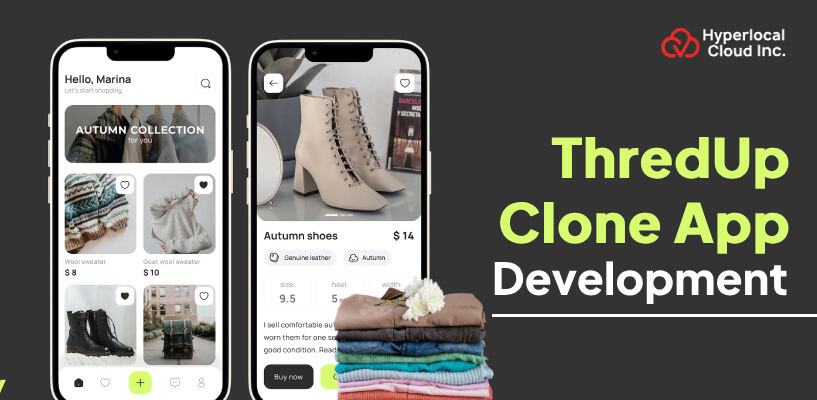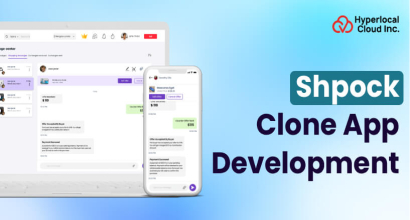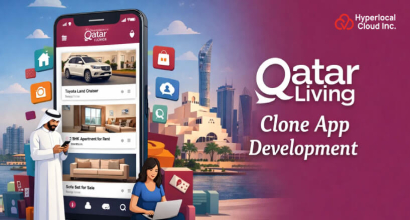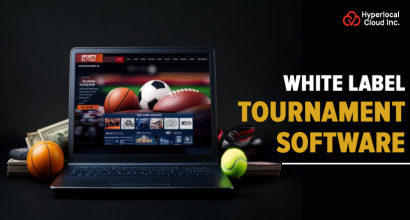The fashion business has been going through a significant transition in recent years. Customers are becoming increasingly aware of the negative environmental impacts of fast fashion and the substantial amount of waste generated when clothing is discarded after a brief period of use.
One of the most popular platforms in this field is the ThredUp app. It has completely changed how people buy used clothing by offering a reliable, practical, and easy-to-use marketplace. The app helps sellers clear out their closets and make money while enabling consumers to purchase premium used clothing at reduced costs.
According to some reports, it is suggested that the digital thrift shopping app marketplace is projected to reach around $48.32 billion by 2025 and is expected to reach around $138.90 billion by 2035.
In this blog, we will explore the details of a ThredUp clone app, including its key benefits, essential features, development process, and business model.
What is the ThredUp App?
ThredUp is an app that specializes in secondhand clothing. It enables users to purchase and sell used apparel, accessories, and shoes, mainly for women and children; however, men's clothes are also available. Because ThredUp uses a consignment model, sellers send their used clothing to be photographed, examined for quality, and then put up for sale on the app.
Start Building Your Own ThredUp-Like App Today
How Does a ThredUp Clone App Work?
A ThredUp clone app is designed to replicate the key functionalities of the original ThredUp app. It serves as a marketplace where users can both buy and sell secondhand clothing conveniently. The working of such an app involves several stages, which create a smooth flow between sellers, buyers, and the platform.
1. Seller Onboarding
In order to use the app, sellers must first register by entering their name, contact information, and preferred method of payment. With the help of social network sign-up tools, this process can be made simple and quick.
2. Listing items for Sale
Sellers submit pictures of the clothing they wish to sell along with thorough descriptions that include the brand, size, condition, and price. The ThredUp consignment concept is used by specific clone applications, in which merchants submit their clothing for quality control before listing it.
3. Quality Inspection
The platform typically conducts a quality check on the clothing to ensure it meets the specific requirements of the buyers. This stage stops products that are damaged or of poor quality from being listed.
4. Product Listing and Browsing
Buyers can view approved items in the app. Customers can use filters to choose products that fit their interests and browse products by size, brand and category.
5. Purchase Process
After selecting their goods, customers add them to the shopping cart. The app supports many payment options, such as digital wallets, credit and debit cards, and cash on delivery in some situations.
6. Order Processing and Shipping
The platform handles the logistics after the purchase. Depending on the business model, either the platform manages shipment through partners or the seller sends the product directly. Buyers are given tracking information for accountability and transparency.
7. Delivery and Returns
The buyers receive their deliveries. The app ensures customer satisfaction by providing a simple return or refund procedure in compliance with company policy in the event that the product does not live up to expectations.
8. Seller Earnings
The platform pays the seller's payment after the sale is confirmed and the return window has passed. Sellers can use approved payment methods to withdraw their profits after the platform deducts a certain amount of fee.
How is ThredUp Clone App Development Beneficial for Businesses?
There are many advantages for companies looking to get into the expanding resale apparel sector by developing a ThredUp clone software. Let's take a closer look at these advantages:
1. Growing Market Demand
The market for used apparel is growing quickly on a global scale. Cost-effective substitutes for brand-new apparel are preferred by consumers who are growing more environmentally concerned. Businesses can access this booming market with a proven business plan by creating a ThredUp clone app.
2. Reduced Inventory Risk
Resale platforms don't need to maintain their own inventory, unlike traditional retail establishments. Because sellers supply their own clothing, storage and initial investment expenses are decreased. This concept improves flexibility while reducing financial risks.
3. Attracting Eco-Friendly Customers
Consumers of today are searching more and more for sustainable solutions. Businesses may draw in and keep clients who appreciate eco-friendly buying by providing a resale platform. This promotes a favorable reputation and brand loyalty.
4. Multiple Revenue Streams
Thredup Clone apps can generate revenue through commissions on listing fees, seller membership plans, purchases, ads, and premium storage facilities. This diverse income model ensures stable and scalable revenues.
5. Leverage Advanced Technology
Companies can use advanced technology, such as artificial intelligence (AI), for individual recommendations and ensure payment channels through app development. This, however, will increase user interaction and enhance their overall experience.
6. Scalable Business Model
The software can be expanded by introducing new product categories, such as accessories or household items, after adding multiple features, entering other markets, or once it has gained user interaction. Its scalability makes it a successful, long-lasting commitment.
7. Data Insights for Growth
The program collects valuable data on user behavior, sales trends, and popular products. Companies can use this information to improve their marketing, inventory, and pricing strategies.
Explore the Features of a ThredUp Clone
Buyer, seller, and admin are essential features across the three primary panels, which are necessary for a ThredUp clone app to attract customers. Let's take a closer look at the features mentioned below.
Buyer Panel
1. User Registration and Login
Users can easily create accounts by using social media accounts, names, contact information, or email addresses. This is the first step in adapting the buying experience.
2. Product Browsing
A wide catalog that provides alternatives for filtration by size, brand, price, color, and category allows customers to see what they look like.
3. Detailed Product Pages
Each product entry includes excellent images, complete details, seller reviews, and shipping details. This openness increases the likelihood of buying.
4. Wishlist
This feature enables users to add their favourite objects to the wishlist, which can be shared with friends or saved for later viewing.
5. Shopping Cart and Checkout
Simple trolley functionality allows for adding or removing items, and an inventory box process guarantees that the purchase is completed without bottlenecks.
6. Multiple Payment Options
Accepting various payment options, including digital wallets, paperless transactions, credit/debit cards, and possibly cash-on-delivery, enhances customer convenience.
7. Order Tracking
From shipment to delivery, buyers receive real-time updates on the placement of the order.
8. Ratings and Reviews
Customers can post reviews of goods and suppliers, helping the public make informed decisions.
9. Return Management
The buyer's confidence is increased by direct return procedures and reimbursement requests.
10. Push Notifications
Users receive alerts about new clothing arrivals, discounts, order updates, and notifications of customised offers.
Seller Panel
1. Seller Registration and Verification
To begin selling, sellers only need to register and provide identification. With the help of this feature, sellers can complete this process smoothly.
2. Product Upload
This feature enables sellers to categorise products, provide detailed descriptions, add images, and set prices.
3. Inventory Management
A dashboard of inventory management enables the sellers to monitor sold goods, pending shipments, and available products.
4. Order Management
With the help of this feature, sellers are enabled to arrange shipments, examine new orders, and update status.
5. Earnings and Withdrawals
This will allow the sellers to monitor their sales, request payment withdrawals, and see commissions deducted.
6. Messaging System
The feature of in-app messaging connects sellers and buyers. Because asking questions and seeking clarification from buyers or the admins increases transparency.
7. Shipping Labels
This feature is helpful because if the platform manages logistics, shipping labels can be downloaded or printed.
8. Performance Analytics
Sellers may enhance their performance by gaining insights about inventory, buyer feedback, and sales patterns.
Admin Panel
1. User Management
The administrator has the ability to control buyer and seller accounts, confirm users' identities, and prevent fraudulent activity.
2. Product Approval
The seller's uploaded goods can be examined and authorised before construction, ensuring quality.
3. Order and Payment Management
Keep a close eye on each transaction, handling both the seller's payment and the refund.
4. Commission Settings
The administrator can specify fee and commission rates.
5. Reports and Analytics
Date-driven decisions, revenue, user activity, sales, and products help with extensive reports of popularity.
6. Content Management
The ability to supervise advertising campaigns, banners, and categories.
7. Customer Support Management
Equipment for effective management of complaints, disagreements, and investigations.
8. Security Controls
Users implement measures to protect information and prevent fraud and unauthorised access.
Ready to Enter the Circular Fashion Market?
What are the Advanced Features of a ThredUp Clone App?
Adding advanced features is crucial for installing Thredup Clone apps or the Vinted clone app, in addition to those of competitors, and promoting user storage. These properties increase operational efficiency and improve the revenue system.
1. AI-Powered Product Recommendations
Artificial intelligence examines their browsing and buying history to recommend analog products that are more likely to be purchased by consumers. As a result, sales increase and customer satisfaction improves.
2. Virtual Try-On Technology
Customers can use cameras on their phones to make visual efforts on clothes or accessories through virtual reality technology. By providing a more accurate representation of what the product will look like in real life, it helps reduce returns.
3. Sustainability Score or Badge
This feature results in highlighting sustainable-friendly products. Thus, this feature will appeal to long-term brands and attract ethical consumers.
4. Social Media Integration
On social networks, users can post things they share with the app. It attracts new users and improves biological reproduction.
5. In-App Chat Support
By facilitating communication between buyers and suppliers in the app, the survey on goods, cost, or shipping increases black self-confidence and openness.
6. Loyalty and Rewards Program
Referral points, discounts, loyalty programs, or suppliers offer special access and enhance customer value throughout their lifetime.
7. Bulk Listing and Bulk Buying Options
Bulk upload functionality saves time for sellers who have a lot of items. Bundles can be purchased at a discount for customers interested in purchasing multiple items.
8. Geo-Location Based Services
Convenience is increased by enabling quicker delivery or local pickups by allowing customers to sort products by location.
9. Multi-Language and Multi-Currency Support
The app supports multiple languages and currencies, making it accessible worldwide and enabling it to target international audiences.
10. AI-Powered Pricing Suggestions
To maximize sales, provide merchants with suggested prices based on demand, product condition, and market trends.
The Steps We Consider for a ThredUp Clone App Development
To ensure that a methodological approach is required when creating a ThredUp clone app to meet the user's expectations and business goals. So, follow the steps below and learn how to develop an app like Mercari and ThredUp.
1. Market Research and Analysis
It is essential to understand the preferences and needs of the target group before development begins. Check rivals like Tradup and Poshmark if the work is good and where changes are needed. Explore popular product categories, regional requests, and current market trends.
2. Requirement Gathering
Compare technical and business requirements in detail. Choose target platforms including web, iOS and Android. Describe the main functions, user roles, income plants' strategy and financial limitations.
3. UI/UX Design
For a smooth experience, create an easy-to-use interface and have spontaneous navigation. Create a high-level prototype to visualise how the app will appear and function after designing the wireframe that outlines its structure. To make it easier for all user groups to use, the design must be both attractive and straightforward.
4. App Development
The development stage involves coding the app’s front-end and back-end components based on the defined requirements and design. Developers implement features such as product catalogs, user profiles, shopping carts, order tracking, and secure payment processing, using scalable technologies to support future growth.
5. Third-Party Integrations
To enhance functionality, the app integrates with external services like payment gateways, shipping APIs, analytics tools, and social media platforms. These integrations streamline operations, improve user convenience, and enable features such as real-time tracking, secure transactions, and marketing analytics.
6. Testing and Quality Assurance
To ensure the app is flawless, compatible with a variety of screens and devices, and performs safely, extensive testing is performed. Functional, performance, purpose, and safety tests are among the several forms of tests.
7. Deployment
Once testing is complete, the app is deployed to production environments such as app stores or web servers. This step involves setting up hosting, configuring databases, and ensuring the app is accessible to users with minimal downtime or disruptions.
8. Marketing and Launch
Develop a marketing strategy that utilises SEO, advertising, impressive marketing, and social media to effectively market the app. Focus on marketing efforts to incorporate both buyers and suppliers.
9. Maintenance and Updates
Monitor user reviews and app performance continuously. Maintain the competition and relevance of the app by constantly adding new features, addressing problems and providing timely updates.
Understand the Monetization Strategies of a ThredUp Clone
Using effective monetization techniques is crucial for creating a resale app that is both profitable and successful. The following are typical methods for making money with a ThredUp clone app:
1. Commission on Sales
Receiving a commission for each successful sale is the most widely used approach. Typically, this charge is a portion of the product's retail price. It provides a steady stream of income in proportion to sales volume.
2. Listing Fees
Offer premium paid listings that receive more exposure in search results or featured areas, or charge sellers a fee to list every item.
3. Subscription Plans
Offer membership packages to sellers that include perks such as priority service, bulk listing, and reduced commission rates. As a result, the monthly revenue becomes steady.
4. Advertising and Promotions
Provide companies or merchants with ad spots so they can advertise their goods within the app. You can make extra money by running in-app promotions during sales or events.
5. Transaction Fees
To cover operating expenses, include fixed fees for currency conversion or payment processing.
6. Affiliate Marketing
Collaborate with fashion companies or services to market their goods to app users and receive commissions.
Ready to launch your own resale fashion marketplace?
How much does it cost to develop a ThredUp Clone App?
The cost for ThredUp clone development starts from $5,000. This is just a rough cost estimation because there is a wide range of crucial factors that typically affect the development cost. However, selecting a budget-friendly and experienced on-demand app development company would be a great initiative to start the business and achieve positive results. Moreover, by reaching out to the development companies, you can get a detailed cost estimation.
What are the Factors that Affect the ThredUp Clone App Development Cost?
The overall cost of creating a ThredUp clone app depends on several factors. Comprehending these aids in planning and budgeting.
1. Feature Set and Complexity
The time and cost of development are directly affected by the number and complexity of functions. While apps with sophisticated features and integration are more expensive, basic apps with essential functionality are usually cheaper.
2. Platform Choice
Typically, designing an app is more cost-effective for a single platform, such as iOS or Android. Although development across platforms can save money, it can also cause performance issues.
3. UI/UX Design
More time and talented designers are needed for custom, complex designs, which raises the price. Designs that are simple or based on templates are less expensive.
4. Development Team Location
Compared to hiring local developers in high-cost countries, hiring developers from countries with cheaper rates (offshore development) can save money.
5. Third-Party Integrations
The cost is increased by licensing and development work for payment gateways, shipping APIs, AI services, and other interfaces.
6. Backend Infrastructure
Complexity and expense increase when a robust backend is built to manage user data, transactions, and security.
7. Testing and QA
Although it takes more time and money, thorough testing guarantees a seamless and safe app.
8. Maintenance and Updates
A budget beyond initial development is also needed for ongoing upkeep and the installation of new features.
The Key Factors that Help to Reduce the ThredUp Clone App Development Cost
Businesses can employ several strategies to reduce the cost of ThredUp clone app development without compromising the quality of their apps.
1. Minimum Viable Product (MVP) Approach
To reduce the market demand, start by creating a simple app with just the most essential functionality. Later, depending on the user's answers and financial obstacles, add more complex features.
2. Use Ready-Made Solutions
Use the open-source library, framework, or ready-made solution to accelerate growth and reduce expenses. This would be a great alternative to grow your business with budget-friendly solutions.
3. Cross-Platform Frameworks
Use a single codebase for both iOS and Android when creating an app with React Native or Pulsing to save time and money.
4. Outsourcing to Skilled Developers
We collaborate with seasoned offshore developers or teams that have a successful track record in order to provide top-notch work at affordable costs.
5. Clear Requirements and Planning
Apparently, demands save money by reducing the time spent on research and development. Thus, businesses should maintain a clear plan and blueprint for app development.
6. Cloud-Based Infrastructure
To avoid significant upfront costs, use cloud services with a pay-as-you-go pricing model for hosting and backend services.
Why Approach the Hyperlocal Cloud?
Businesses, startups, or entrepreneurs looking to enter the thrift shopping marketplace can reach out to Hyperlocal Cloud, one of the leading custom software development companies. Our expert team analyses your business requirements and then serves to fulfil your needs. From technology advancement to AI and API integrations, you will get in the ThredUp clone app. So, leverage our tech expertise to turn your dream project into a reality. Contact us now to get a free consultation.
FAQs (Frequently Asked Questions)
Why should I invest in a ThredUp-like app?
With the growth of sustainable fashion and the circular economy, secondhand fashion platforms are booming. A ThredUp clone app offers a great opportunity to tap into the $84B+ global resale market.
Can I customize the ThredUp clone app according to my brand?
Yes. Most clone app developers offer white-label solutions, allowing you to fully customize the design, features, and branding to match your business vision.
Do I need a custom-built app, or can I use a ready-made script?
It depends on your goals. Ready-made scripts offer faster, more affordable launch options, while custom development gives you flexibility, scalability, and full brand control.
How do I ensure secure payments on my resale app?
Integrate trusted payment gateways like Stripe, PayPal, or Square, and ensure SSL encryption, PCI compliance, and fraud detection features are in place.
Can I scale the app to other niches beyond clothing?
Absolutely. You can tailor the platform to other secondhand verticals such as electronics, books, furniture, or children’s gear, using the same base functionality.
What makes a ThredUp clone different from a generic eCommerce app?
Unlike general eCommerce platforms, ThredUp clones focus on secondhand fashion. They typically include features like quality inspection, seller verification, and logistics support for used items.
How long does it take to develop a ThredUp clone app?
It depends on the complexity. A basic MVP (minimum viable product) can take 4–6 weeks. A fully featured, scalable app may take 3–4 months.



